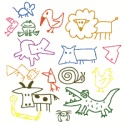 Let me tell you about my collection of really bad animal question-and-answer books.
Let me tell you about my collection of really bad animal question-and-answer books.
This is a genre that thrived back before the Internet (mostly between 1930 and 1960) when connoisseurs of weirdness and misinformation had only bound books to turn to. Its heroes include Osmond P. Breland (author of the classics “Animal Facts and Fallacies”, “Animal Friends and Foes”, and “Animal Life and Lore”) and Alan Devoe (who gave us “Speaking of Animals” and “This Fascinating Animal World”).
Here’s a six-question quiz I compiled from these books.
- Can a toad live for years sealed up in solid rock?
- Can a dog procreate with a skunk?
- Do snakes swallow their young to protect them from danger?
- Can salamanders live in fire?
- Is the rattlesnake a gentleman?
- Can male animals lay eggs?
Scoring: Give yourself 1 point for each “no” answer. (The answers, in fact, are all “no”.) If your score is between 0 and 5, you are mentally disturbed. If your score is 6, you might not be.
While these questions might seem to have been generated by a monkey at a typewriter, at least some of them appear to have been taken seriously by actual human beings. Take for example the distinguished Toad Scientist William Buckland of Oxford University. I learn from “Animal Life and Lore” that in 1825, Reverend Buckland took the trouble to seal 24 toads in solid rock to see what would happen. After a year, the toads were exhumed and all 12 of the toads that had been sealed in nonporous sandstone were dead. Remarkably, some of those who had been sealed in porous limestone were alive. (It was suspected that air, insects and moisture had all made it through the pores.) Therefore, Buckland sealed them back up for another year, after which they were all good and dead. (In the 19th century, science was a serious endeavor, and there were no People for the Ethical Treatment of Toads to impede its progress.) According to Breland:
Buckland’s experiments prove that it is impossible for toads to live for any great length of time completely sealed in solid rock.
Who could argue?
Buckland’s experiments aside, the preponderance of “no” answers to these questions is due primarily to the fact that they are mostly of the form “Is it true that animal X does Y?”, where no sane person would ever have thought to imagine that animal X does Y. Not always, though. In “This Fascinating Animal World” I find the question: “Is a bat the only animal that can fly?”. The answer is “yes”.
(In fairness, Devoe has warned us, 50 pages earlier, that in this section of the book—though not in later sections—he will use the word “animal” to mean “mammal”. He does not, however, take the opportunity to remind us of this usage. Somewhat oddly, he does not use the word “mammal” to mean “sheep”.)
Those of you raised in the Internet era might think that the tone, quality and reliability of these books have a familiar ring to them. In some ways, though, they are products of an entirely different time. When Osmond Breland asks “What can you do with a walrus?”, his answer is: Pretty much nothing. I bet the Internet will tell you different.



The bygone days of the How and Why Wonderbooks. How things have changed.
If you take requests, I’d love to hear some of the nonfiction books that blew your daughter away elementary age and earlier. (Already have Gonick’s Cartoon History of the Universe books salted away based Bryan Caplan’s praise)
Yah just don’t type that last question into google images…especially at work.
While male animals cannot lay eggs, the male seahorse does carry the eggs for the female after the female has deposited them in his body:
http://en.wikipedia.org/wiki/Seahorse#Reproduction
although it wouldn’t take much work to add some much more interesting facts to Wikipedia, including some suggestions on what you can do with walruses…
There are species that can change sex in response to environmental conditions, so in a sense a male can lay an egg. He just has to change into a female first.
The internet will tell you that you can take buckets away from walruses.
http://media.photobucket.com/image/be%20stealin%20my%20bucket/DuncMan/TheyBeStealinMyBucketSeal.jpg
A question that, once raised, will be answered.
Is that last line invoking Rule 34 on walruses?